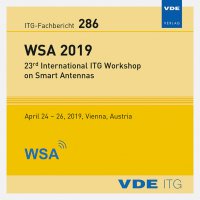Investigation of Hybrid-MIMO Configurations for Office Docking in the 60 GHz Band
Konferenz: WSA 2019 - 23rd International ITG Workshop on Smart Antennas
24.04.2019 - 26.04.2019 in Vienna, Austria
Tagungsband: WSA 2019
Seiten: 5Sprache: EnglischTyp: PDF
Persönliche VDE-Mitglieder erhalten auf diesen Artikel 10% Rabatt
Autoren:
Fellhauer, Felix; Brink, Stephan ten (University of Stuttgart, Institute of Telecommunications, 70569 Stuttgart, Germany)
Loghin, Nabil (SONY EuTEC, Stuttgart Technology Center, 70327 Stuttgart, Germany)
Inhalt:
This work focuses on comparison of physical layer performance for 60GHz wireless local area network (WLAN) systems, when advancing from single-input single-output (SISO) systems to multiple-input multiple-output (MIMO). Simulation results of 60GHz indoor hybrid-MIMO (H-MIMO) channels for the specific application of office docking are presented. Three different transceiver configurations are investigated: A SISO configuration consisting of a single analog precoder, antenna array and radio frequency (RF) chain; second, a H-MIMO configuration with two RF chains, each feeding an analog precoder and a single antenna array; and third, a configuration with two spatially separated antenna arrays each connected to a dedicated analog precoder and RF chain. Simulations are conducted based on the IEEE 802.11ay (11ay) channel model featuring a ray-tracing based quasi deterministic (QD) approach. For analog precoding and combining, a codebook based low complexity algorithm is used that is well aligned to the two stage beamforming scheme defined in 11ay. All configurations are compared with respect to achievable mutual information and scenario specific parameters like device position and orientation. Results show that H-MIMO increases the mean rates by up to ~ 62.9% with spatial separation when compared to the SISO case.


